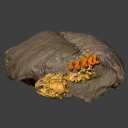3D models of early strepsirrhine primate teeth from North Africa
3D models of Pontognathus ignotus and Massetognathus pascuali
3D models of Protosilvestria sculpta and Coloboderes roqueprunetherion
3D GM dataset of bird skeletal variation
Skeletal embryonic development in the catshark
Bony connexions of the petrosal bone of extant hippos
bony labyrinth (11) , inner ear (10) , Eocene (8) , South America (8) , Paleobiogeography (7) , skull (7) , phylogeny (6)
Lionel Hautier (22) , Maëva Judith Orliac (21) , Laurent Marivaux (16) , Rodolphe Tabuce (14) , Bastien Mennecart (13) , Pierre-Olivier Antoine (12) , Renaud Lebrun (11)
MorphoMuseuM Volume 08, issue 03
<< prev. article next article >>

|
Original article : type specimenA surface scan of the "Tübingen Steinkern", Holotype of Proganochelys quenstedtii (Testudinata), with some historical remarks.Ingmar Werneburg
Published online: 08/08/2022 |

|
M3#967This the surface model of the steinkern of the shell of Proganochelys quenstedtii. Type: "3D_surfaces"doi: 10.18563/m3.sf.967 state:published |
Download 3D surface file |
Ballerstedt M., 1922. Über das Plastron der Schildkröten des Keupers und die Gestalt der Panzerschale von Proganochelys Quenstedtii Baur nach dem Tübinger Fossil. Palaeontologische Zeitschrift 4, 65–74. https://doi.org/10.1007/BF03041559
Baur G., 1887. Ueber den Ursprung der Extremitäten der Ichthyopterygia. Bericht über die XX. Versammlung des Oberrheinischen geologischen Vereins zu Metzingen in Württemberg, 14. April 1887, 17–20.
Baur G., 1888. Osteologische Notizen über Reptilien (Fortsetzung III). Zoologischer Anzeiger 285, 417–424
Cope E. D., 1873. On the Extinct Vertebrata of the Eocene of Wyoming, with Notes on the Geology. In: Vandeveer Hayden F. (Ed.), Annual Report of the United States Geological Survey of the Territories 6, p. 648.
Cope E. D., 1883. The Vertebrata of the Tertiary Formations of the West, Book I, Washington, p. 114.
Engelhardt W. v., Hölder H., 1977. Mineralogie, Geologie und Paläontologie an der Universität Tübingen. J.C.B. Mohr (Paul Siebeck), Tübingen.
Edinger T., 1929. Die fossilen Gehirne. Julius Springer, Berlin.
Fraas E., 1899. Proganochelys Quenstedtii BAUR (Psammochelys Keuperina QU.). Ein neuer Fund der Keuperschildkröte aus dem Stubensandstein. Jahreshefte des Vereins für vaterländische Naturkunde in Württemberg 55, 401–424.
Gaffney E. S., 1990. The comparative osteology of the Triassic turtle Proganochelys. Bulletin of the American Museum of Natural History 194, 1-263.
Jaeger G. F., 1828. Über die fossile Reptilien, welche in Württemberg aufgefunden sind. Verlag der Metzler'schen Buchhandlung, Stuttgart. https://doi.org/10.5962/bhl.title.4689
Joyce W.G., 2017. A review of the fossil record of basal Mesozoic turtles. Bulletin of the Peabody Museum of Natural History 58(1), 65–113. https://doi.org/10.3374/014.058.0105
Plieninger T., 1846. Nachträgliche Bemerkungen zu dem Vortrage (S. 148 dieses Heftes) über ein neues Sauriergenus und die Einreihung der Saurier mit flachen, schneidenden Zähnen in eine Familie. Jahreshefte des Vereins für Vaterländische Naturkunde in Württemberg 2, 247-254.
Quenstedt F. A., 1889a. Das Mineralogische und Geognostische Institut. In: Universität Tübingen (Ed.), Die unter der Regierung seiner Majestät des Königs Karl an der Universität Tübingen errichteten und erweiterten Institute der Naturwissenschaftlichen und Medizinischen Fakultät.
Quenstedt F. A., 1889b. Psammochelys Keuperina. (ψάμμος Sand, Χέλυς Schildkröte.). Jahreshefte des Vereins für vaterländische Naturkunde in Württemberg 45, 120–130.
Walther J., 1922. Eberhard Fraas. Verhandlungen der Gesellschaft Deutscher Naturforscher und Ärzte 87: 334–336.
Werneburg I., Hinz J. K, Gumpenberger M., Volpato V., Natchev N., Joyce W. G., 2015. Modeling neck mobility on fossil turtles. Journal of Experimental Zoology B Molecular and Developmental Evolution 324(3), 230-243. https://doi.org/10.1002/jez.b.22557